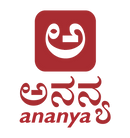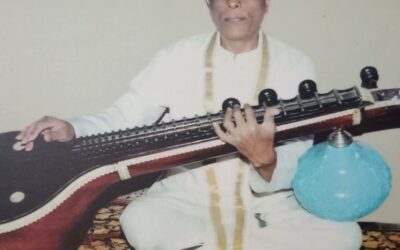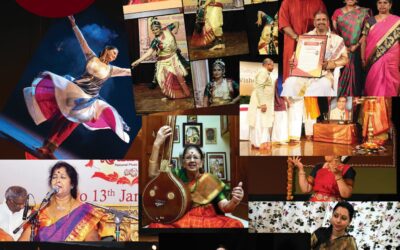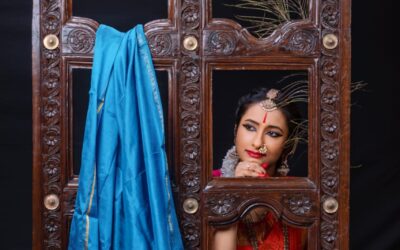Iti Margam
On the path, best friend in hand.
– An observation by a mildly active Rasika with smattering interests, aka SJS
Iti Mārgam, a collaborative showcase by Aruna Bhargavi and Jagadishwar Sukumar, senior students of Smt. Ramaa Venugopalan, was presented on the 1st of July, 2022 at Seva Sadan, Bengaluru. Working with the flow of the traditional Bharatanatyam repertoire, they presented an honest, well-ideated evening of dancing exploring between them the joy, strength, and purpose of the Mārgam – rooted in the path with endearing friendship.
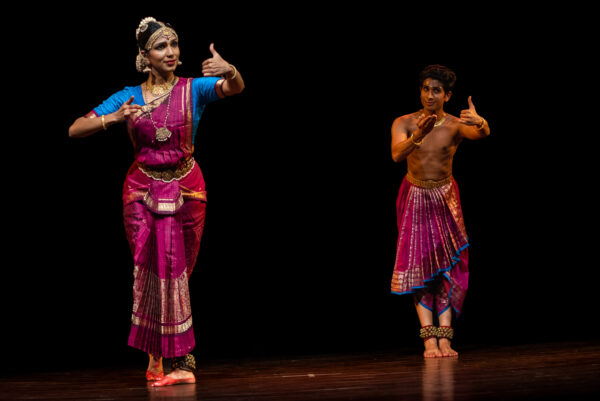
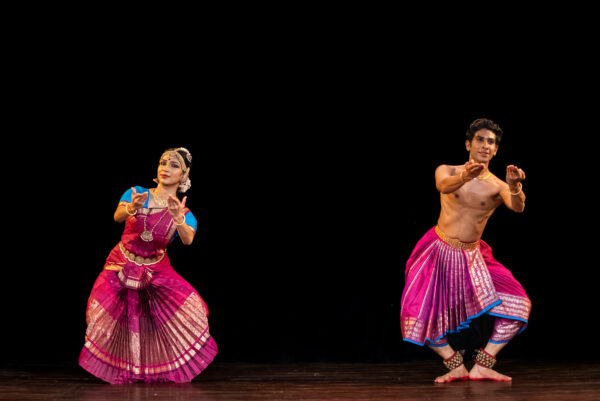 Often, dancers tend to approach the Mārgam format with quixotic whims of reinventing the wheel to create distinctive and presuming unimagined explorations. The glorious days of the Mārgam presentation is well behind us – with dancers find the pressing requirement to create a brand for themselves, an identity that is distinctive and relevant.Arbitrary markers like Instagram followers and likes bestowing clout, visibility, and undue credibility to a certain fringe, to perform and stay relevant is beyond hard work for young upcoming artists. It’s easy to compromise the principles and tradition with odds stacked up against them. This pushes many dancers to run on fumes, to constantly create content from the place of pretensions, barely giving them time to enjoy their choreography.
Often, dancers tend to approach the Mārgam format with quixotic whims of reinventing the wheel to create distinctive and presuming unimagined explorations. The glorious days of the Mārgam presentation is well behind us – with dancers find the pressing requirement to create a brand for themselves, an identity that is distinctive and relevant.Arbitrary markers like Instagram followers and likes bestowing clout, visibility, and undue credibility to a certain fringe, to perform and stay relevant is beyond hard work for young upcoming artists. It’s easy to compromise the principles and tradition with odds stacked up against them. This pushes many dancers to run on fumes, to constantly create content from the place of pretensions, barely giving them time to enjoy their choreography.
Iti Margam, however, stuck to its ethos and made a noticeable impression. The decision to forego tiresome items like the Todayam, Pushpanjali, Shloka often performed in the perfunctory with the solitary aim of appeasing the traditionalists was admirable. The duo cut right to chase and brought to stage a brisk, refreshing Alarippu in Mishra Chapu Talam. Sharp and strong body work with pleasing moments of joy and friendship throughout, it perked up the audience up for the evening’s recital. Sri Vazhuvoor Ramaiah Pillai’s Keeravani Jathiswaram served as a highlight in choreography – deviating to the individual paths of the duo and eventually coming together in a confluence rooted firmly in the Vazhuvoorar Baani. The idea was well executed, notably breaking all expectations. Jagadishwar relayed a sparkling string of Mārga Karanas, a path he has been passionately exploring. His graceful, intuitive flow of the movements more than made up for the lack of finer awareness of the technique.Aruna, displayed her strong foothold to handle the nimble traditional adavus, secure in her resolve, and unflinching in conviction of her chosen path. The Jathiswaram was a visual celebration, with the lovely pink and blue costumes adding to the vibrance. There was semblance of filmy grace, reminiscent of the actress Padmini and Kumari Kamala. Establishing the musical landscape of the Varnam, an eargasmic prelude by the flautist, Sri. Mahesha Swamy handled with such authority and flair, melded together in reverse order all the ragas of the Ragamalika Varnam in Rupaka Talam setting the tone of what is to follow. The duo found their emotive footing, displaying layered complexity in their emotions, coaxing Lord Brihadeshwara for His companionship as imagined by the poet Ponniah Pillai in the magnificently popular “SAmi ninnE kOri nAnurA”. One could appreciate the individual paths of emoting taken by the dancers, seeking ways of attaining the Lord. Aruna sparkled spectacularly in the Varnam, with her pleas and earnest love for Lord Brihadesha. It conquered it all for me because it was honest and heartfelt. There were few low moments in the Varnam; Sancharis and the Vaakyartha of the verses were limited in their exploration. The emotive quality, however, picked up in the verse, ‘prEma mIraga tanjapuri vAsA’ and ‘sArasa guNa vanitA paravashamai’. There were hardly a handful of clumsy missteps, which the duo handled as veterans would. The Tri-KAla Jati was absolutely exquisite, with many of the Nrtta sequences designed as off-centre moments breaking from unstimulating geometry, weaving in and out of harmony. Something I have privately appreciated in the choreographic practice of Ramaa Venugopalan Akka. The focus is on the individual and the momentary departure from co-ordinated work into individual exploration of the melody, rhythm or poetry, each building on their own imagination, at their own pace. I find this important as it creates a comfortable space and pace, not blind conformation. However, this sort of incongruous exploration can sometimes clutter the visual space, making it hard to focus for a trained eye. Jagadishwar made the audience blush, gasp and turn away bashfully while dealing with his solo exploration of “Marulu neepai unTira”, a largely unknown piece by Lakshmikanta Kavi, seen ages ago on the silver screen. Displaying measured maturity in walking the line between tasteful and vulgar, sensual and vulnerable lines on stage, he came into his own with this steamy sentiment portraying frustrated attempts to seduce his preoccupied partner. The implied narrative of the couple sharing such a sentiment was beautiful, with the flute effect adding to the mood of the piece. Jagadishwar’s humour and self-assurance reflected in every limb and made this piece the most memorable portrayal of the evening. The vocalist, Smt. Vasudha Shastry gave this piece the intensity, adding raunch in her enunciation of the Pallavi, set in Raga Shanmukapriya and trailing into Begada. Aruna’s individual piece was “Yaarukaagilum bhayama” in Begada by Sri. Subbarama Aiyer. where she played a confident, secure nayika, nonchalant to the gossip floating around town of her and her paramour. She played this character with a quirky smirk, elan and buckets of confidence as she did with the Varnam.Both the individual pieces showed mature restraint in the Sanchari. There was a clear, cohesive narrative flow without winding up in a confused heap of meaningless gesturing and facial histrionics. The interplay of silence and action is always stark in the choreography as designed by Ramaa Akka, leaving one always guessing.

Iti Margam was ably supported by varied viewership, a demography spanning first time watchers to seasoned veterans. The recital with many first-time watchers saw Ramaa Akka introducing each piece with such mindful consideration of the new viewers; it was a conscious effort to make classical dance less intimidating and creating a relaxed space, to enable an open-minded engagement with the dance form. There was plenty of joyful, open communication and participation between the orchestra and the dancers, the amused chuckles and pride reflected openly by Ramaa Akka as she wielded the Nattuvangam for the evening. The abruptly short rendition of the famous Brindavani Thillana composed by the legend Dr. M. Balamuralikrishna, left us all wanting more. A joyful conclusion to a spectacular show!
In more ways than one, Iti Mārgam was an honest and invested performance by the duo. Their understanding of themselves and the collaborative compromise required of each other seems to have led them to create a distinctive niche for themselves as solo and collaborative performers. I wish them the very best.
*******
Stellar Presentations by Inspirational Artists at Samskruthi Rasaabhinaya Dance Festival
– Kavya Kasinathan
The second series of Rasaabhinaya festival curated by Shri Satyanarayana Raju showcased the sheer excellence and brilliant artistic capabilities of five senior classical dancers and Gurus of our state. The festival was held on July 8th and 9th 2022, at Vyoma Artspace and Studio Theatre and garnered the attention of several connoisseurs, teachers, artists, young dancers and rasikas. The two-day festival was a memorable event which created a space for artists to share their nostalgic and valuable experiences. A festival curated to celebrate the essence of Abhinaya and Rasothbhava, each artist’s approach in portraying and achieving Rasothpathi was unique and refreshing.
The first day of Rasaabhinaya festival featured two versatile artists – Dr. Sheshadri Iyengar and Guru Kiran Subramanyam.

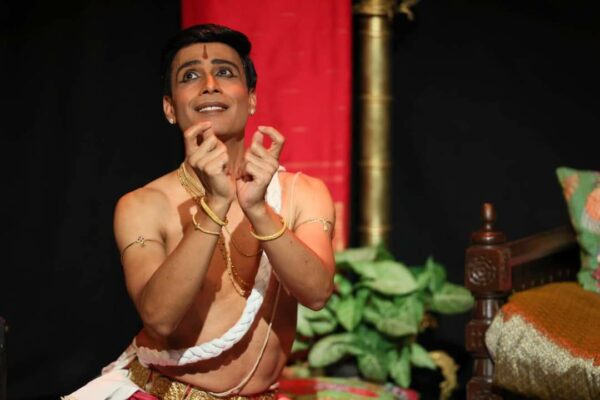 Dr. Sheshadri Iyengar presented an introspective thematic work – “Hrishikesha”. Tracing the life of Ahalya from her youthful days until the time she turns into a stone, “Hrishikesha” dealt with the ability to control our five senses. The production stemmed from the thought that Ahalya represented each of us and Gautama Muni represented the person who would guide us from our materialistic life to a more fulfilling spiritual life which can be achieved if we control our five senses. Dr. Sheshadri began the production by describing Ahalya meeting Gautama Muni for the first time and then proceeded to depict the life of servitude she led in the Ashram of Gautama Muni. Ahalya’s youthful desires correlated with nature’s dance of union was beautifully portrayed. The final sequence showcased Ahalya transcending inwards and controlling the external temptations of the five senses in order to live a fulfilling Satvik life. The usage of short jathis which were recited evocatively and softly by Jayanth Dwarakanath and Ramya Kadambi enhanced the presentation. The innovative costuming from the very choice of colour and style and the usage of stage aesthetics showcased the artistic brilliance of Dr. Sheshadri Iyengar. Vid. Raghuram’s magnetic singing coupled with Vid. Mahesh Swamy’s divine rendition of the flute created a surreal aura, setting the mood for the exuberance that followed.
Dr. Sheshadri Iyengar presented an introspective thematic work – “Hrishikesha”. Tracing the life of Ahalya from her youthful days until the time she turns into a stone, “Hrishikesha” dealt with the ability to control our five senses. The production stemmed from the thought that Ahalya represented each of us and Gautama Muni represented the person who would guide us from our materialistic life to a more fulfilling spiritual life which can be achieved if we control our five senses. Dr. Sheshadri began the production by describing Ahalya meeting Gautama Muni for the first time and then proceeded to depict the life of servitude she led in the Ashram of Gautama Muni. Ahalya’s youthful desires correlated with nature’s dance of union was beautifully portrayed. The final sequence showcased Ahalya transcending inwards and controlling the external temptations of the five senses in order to live a fulfilling Satvik life. The usage of short jathis which were recited evocatively and softly by Jayanth Dwarakanath and Ramya Kadambi enhanced the presentation. The innovative costuming from the very choice of colour and style and the usage of stage aesthetics showcased the artistic brilliance of Dr. Sheshadri Iyengar. Vid. Raghuram’s magnetic singing coupled with Vid. Mahesh Swamy’s divine rendition of the flute created a surreal aura, setting the mood for the exuberance that followed.

 The next segment featured Guru Kiran Subramanyam. From his very entry till the end of the program, he ensured that the atmosphere around was charged with positivity and liveliness. The Konnakol charged entry set the vibrance level of his performance and each composition pushed the bar higher. He presented three popular compositions, all of them revolving around his chosen theme – “Conversations”. He began with an interesting conversation between ‘Dappa’ and ‘Bappa’ depicting an ardent devotee praising the attributes, features and greatness of Ganapathi. The next composition featured a conversation between 2 ‘Jutus’ who were talking about the actions of another woman. The tamil Padam “Athuvum Solluval Aval Anekam Solluval”, was presented in an endearing manner with innovative dialogues interspersed in between. He concluded or rather his entire team – Vid. Raghuram, Vid. Mahesh Swamy and Smt. Shubha Santosh concluded their presentation with “Krishna Nee Begane Baro”, a Devaranama. Here, he depicted Nandagopa conversing with little Krishna who had just caused trouble with his notorious acts. Guru Kiran Subrahmanyam’s presentation was a strong confluence of humour and bhakti which created a lasting impact on the audiences. The expressive actions explaining the naughty deeds of Krishna performed by the multi-talented musical ensemble added more joy and mirth to the presentation.
The next segment featured Guru Kiran Subramanyam. From his very entry till the end of the program, he ensured that the atmosphere around was charged with positivity and liveliness. The Konnakol charged entry set the vibrance level of his performance and each composition pushed the bar higher. He presented three popular compositions, all of them revolving around his chosen theme – “Conversations”. He began with an interesting conversation between ‘Dappa’ and ‘Bappa’ depicting an ardent devotee praising the attributes, features and greatness of Ganapathi. The next composition featured a conversation between 2 ‘Jutus’ who were talking about the actions of another woman. The tamil Padam “Athuvum Solluval Aval Anekam Solluval”, was presented in an endearing manner with innovative dialogues interspersed in between. He concluded or rather his entire team – Vid. Raghuram, Vid. Mahesh Swamy and Smt. Shubha Santosh concluded their presentation with “Krishna Nee Begane Baro”, a Devaranama. Here, he depicted Nandagopa conversing with little Krishna who had just caused trouble with his notorious acts. Guru Kiran Subrahmanyam’s presentation was a strong confluence of humour and bhakti which created a lasting impact on the audiences. The expressive actions explaining the naughty deeds of Krishna performed by the multi-talented musical ensemble added more joy and mirth to the presentation.
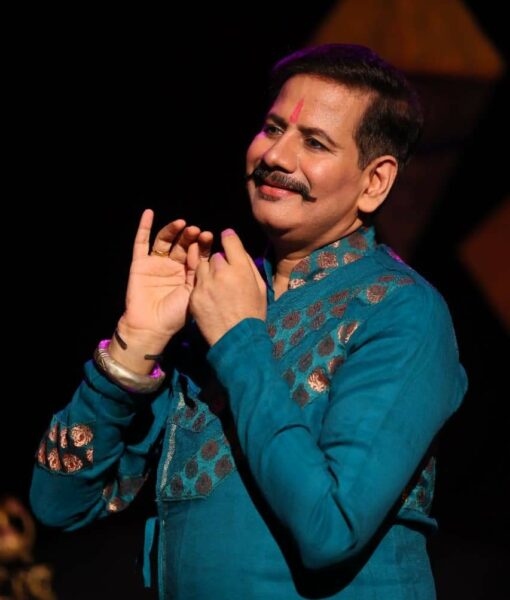
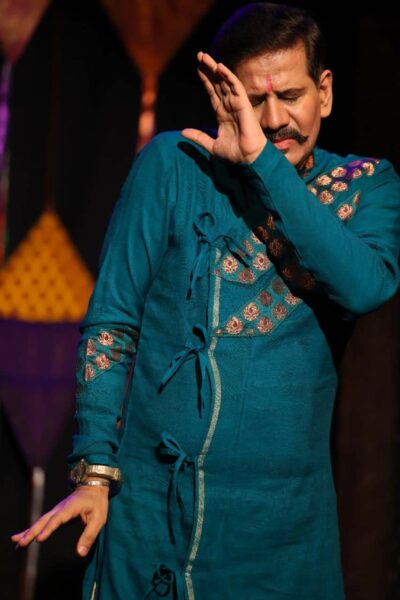 The second day of Rasaabhinaya festival began with a scintillating performance by Shri Murali Mohan Kalvakalva. A creative amalgamation of selected parts of certain Thumris and a composition penned by himself, Guru Shri Murali presented the story of Madhava and Udhava.
The second day of Rasaabhinaya festival began with a scintillating performance by Shri Murali Mohan Kalvakalva. A creative amalgamation of selected parts of certain Thumris and a composition penned by himself, Guru Shri Murali presented the story of Madhava and Udhava.
He began by depicting Krishna reminiscing and narrating to Uddhava the happy times spent in the company of different Gopikas in Brindavan. He then moved on to portray how Uddhava was sent to Brindavan to see Mother Yashoda and the Gopikas. Uddhava’s realisation of Krishna’s greatness provided a befitting finale. Shri Murali’s artistry and creativity was showcased brilliantly throughout the presentation. One of the most captivating and heart wrenching sequences he portrayed was the depiction of Yashoda dreamingly talking to Uddhava about the various leelas of little Krishna while anxiously looking towards the door awaiting his arrival.
The melodious vocals by Samanvitha and the vibrant flute effects by Sri Sandeep enhanced the overall performance taking the entire experience one notch higher.

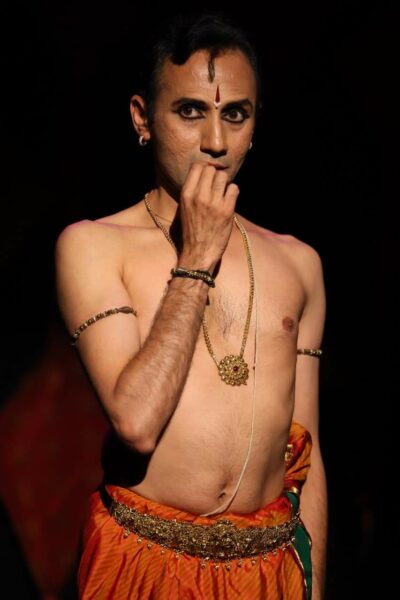 The next presentation featured a Bharatanatyam performance by Shri Praveen Kumar.
The next presentation featured a Bharatanatyam performance by Shri Praveen Kumar.
He began his presentation with a popular Bharatiyar composition – “Chinnanchiru Killiye”. The inexplicable relationship between a father and daughter was captured and expressed through the composition. He then depicted the sensuous bond between Radha and Krishna through the Jayadeva Ashtapadi – “Kshana Madhuna”. Through the Ashtapadi, he portrayed Krishna assuring Radha that he would not be able to stay away from her even for a second. Krishna’s tight embrace which provided them both elixir bliss was a strong portrayal of the divine bond shared between them.
Shri Praveen concluded his presentation with a popular Kannada Bhavageethe – “Hucchukodi Manasu” composed by HS Venkatesh Murthy. In this piece, he depicted a teenage girl admiring herself in front of the mirror and experimenting with different attires and hairstyles. Not only did he transform himself to a sixteen year old girl, but he also made each rasika feel younger! His realistic portrayal of an adolescent teenage girl filled the auditorium with roars of laughter! The emotive and soulful vocals by Vid. Raghuram and Vid. Vivek Krishna’s mellifluous flute rendition enhanced the overall experience of watching a lively performance.

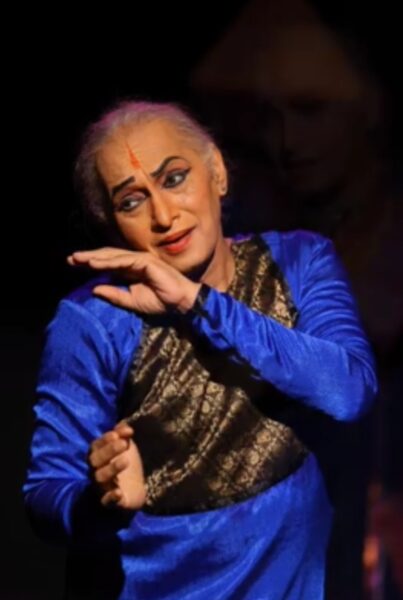 The finale performance of Rasaabhinaya series July 2022, featured Guru Mysore B Nagraj. His performance provided us a sneak-peek of the original form of Khathak that existed in our country before the Mughal invasion. His entire presentation elated the rasikas from the mundane to the divine experiences. He began with a Devaranama -“Madhukara Vritti ennadhu”, which itself was unique choice in a Khathak presentation. Weaving the vocabulary of Khathak into the grammar of Kannada seemed a novel venture and his presentation enthralled the audiences. The portrayal of Ahalya Shapa Vimochanam, Shabari Moksham, Draupadi Vastrapaharanam and the story of Kuchela was crisp yet extremely effective. The second part of his presentation was in set Avadhana format. He brought alive the tradition of ancient Khathakars through his depiction of Radhaantaranga and Amba-Shikandi, both of which were requested by the audience. His performance was a transcendence inwards and elevated each rasika to a state of supreme bliss. Radha’s affirmation that Krishna resides within her having captured her heart through the five different senses and Shikandi’s oscillating struggle to understand herself/himself captured the heart of every rasika present. The enriching vocal support by Vid. Shankar Shanbhog, soothing Sitar accompaniment by Vid. Subramanya and the effective flute support by Vid. Raghunandan added to the overall transcendental effect of the performance.
The finale performance of Rasaabhinaya series July 2022, featured Guru Mysore B Nagraj. His performance provided us a sneak-peek of the original form of Khathak that existed in our country before the Mughal invasion. His entire presentation elated the rasikas from the mundane to the divine experiences. He began with a Devaranama -“Madhukara Vritti ennadhu”, which itself was unique choice in a Khathak presentation. Weaving the vocabulary of Khathak into the grammar of Kannada seemed a novel venture and his presentation enthralled the audiences. The portrayal of Ahalya Shapa Vimochanam, Shabari Moksham, Draupadi Vastrapaharanam and the story of Kuchela was crisp yet extremely effective. The second part of his presentation was in set Avadhana format. He brought alive the tradition of ancient Khathakars through his depiction of Radhaantaranga and Amba-Shikandi, both of which were requested by the audience. His performance was a transcendence inwards and elevated each rasika to a state of supreme bliss. Radha’s affirmation that Krishna resides within her having captured her heart through the five different senses and Shikandi’s oscillating struggle to understand herself/himself captured the heart of every rasika present. The enriching vocal support by Vid. Shankar Shanbhog, soothing Sitar accompaniment by Vid. Subramanya and the effective flute support by Vid. Raghunandan added to the overall transcendental effect of the performance.
Each presentation highlighted the importance of observation and reading. The two-day festival instilled a sense of motivation and inspiration in the minds of young rasikas. Everyone walked out of Vyoma Artspace with a mind filled with food for thought and the conviction to attend and experience more such Rasaabhinayas in the near future.
*****
Vainika Vid. Sri. Mysore. C Krishnamurthy Memorial concert
– Dr. Akshatha Varun
In memory of Vainika Vid. Sri Mysore C. Krishnamurthy, a Veena Recital by Vid.Smt. Vani Yadunandan was held on 16-07-22 at Ananya Auditorium, Malleshwaram, Bangalore. She was accompanied by Vid. Sri. A S N Swamy on the Mridangam and Vid. Sri. Ranganath Chakaravarthy on the Ghatam.
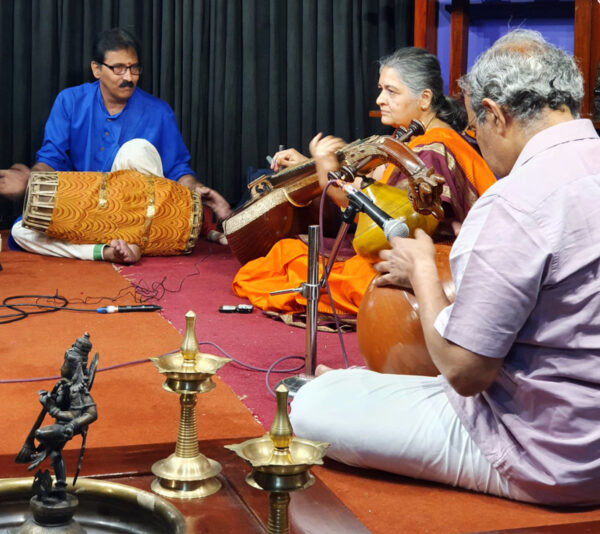 Vid. Smt. Vani Yadunandan began her concert with the well known Hamsadhwani varna, JalajAksha. She then presented a Purandara dAsa devaranAma, Smaraneyonde sAlade in Malaya mArutha set to Adi tAla with a brief Alapana and swarakalpana. She then took up Harikambhoji kriti, SAkethanagara nAtha by Mys. Sadashiva Rao, preceeded with a bhavayuktha Alapana and followed by Swarakalpana. Janani Ninu Vina, a famous composition in Reethigowla set to misrachApu by Shyama Shastry was chosen and rendered with a chaste Reethigowla Alapana. Okapari, in the raga Kharaharapriya set to Adi Tala by Annamacharya, was presented amazingly. Her Veena nAda just captivated the audience. Another composition, AnandAmruthakarshini in the raga Amruthavarshini was chosen and rendered beautifully. The main piece of the concert Rara Rajeeva Lochana by Mys. Vasudevacharya in the raga Mohana was presented with a preceeding, elaborate raga alapana. TAna in Mohana, Saveri and Madhyamavathi was rendered with all embellishments. The swaraprasthara and koriapu was mathematical, flowy and pleasing to the ears. The percussion duo Vid. A S N Swamy and Vid. Ranganath Chakaravarthy accompanied her very well and presented a grand tani Avarthana thereby concluding the concert. The team enthralled the audience with their music.
Vid. Smt. Vani Yadunandan began her concert with the well known Hamsadhwani varna, JalajAksha. She then presented a Purandara dAsa devaranAma, Smaraneyonde sAlade in Malaya mArutha set to Adi tAla with a brief Alapana and swarakalpana. She then took up Harikambhoji kriti, SAkethanagara nAtha by Mys. Sadashiva Rao, preceeded with a bhavayuktha Alapana and followed by Swarakalpana. Janani Ninu Vina, a famous composition in Reethigowla set to misrachApu by Shyama Shastry was chosen and rendered with a chaste Reethigowla Alapana. Okapari, in the raga Kharaharapriya set to Adi Tala by Annamacharya, was presented amazingly. Her Veena nAda just captivated the audience. Another composition, AnandAmruthakarshini in the raga Amruthavarshini was chosen and rendered beautifully. The main piece of the concert Rara Rajeeva Lochana by Mys. Vasudevacharya in the raga Mohana was presented with a preceeding, elaborate raga alapana. TAna in Mohana, Saveri and Madhyamavathi was rendered with all embellishments. The swaraprasthara and koriapu was mathematical, flowy and pleasing to the ears. The percussion duo Vid. A S N Swamy and Vid. Ranganath Chakaravarthy accompanied her very well and presented a grand tani Avarthana thereby concluding the concert. The team enthralled the audience with their music.
******
